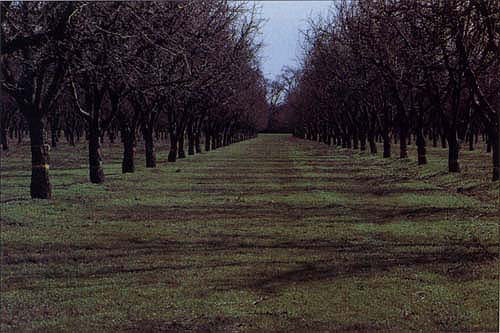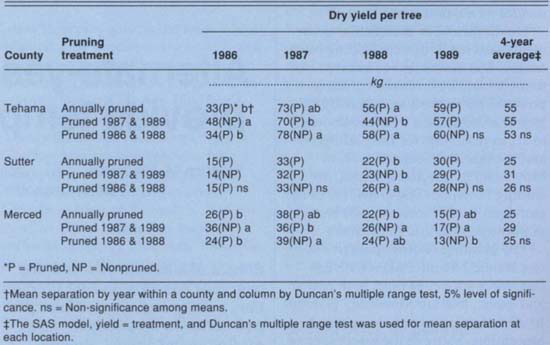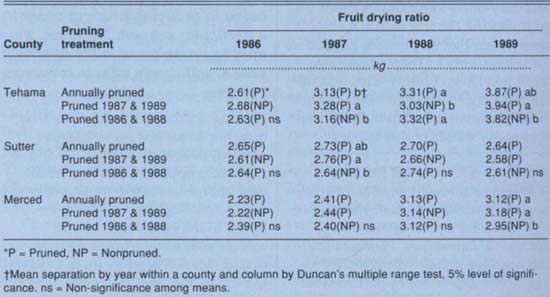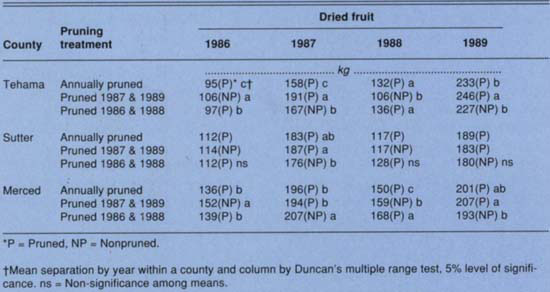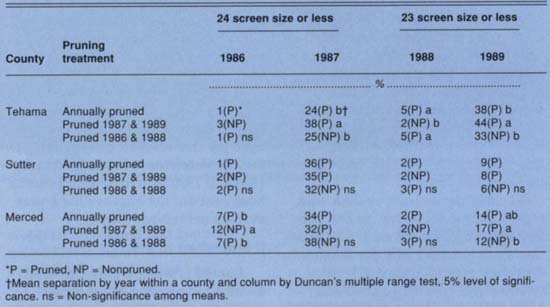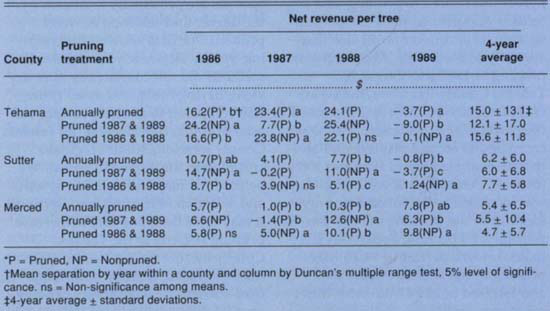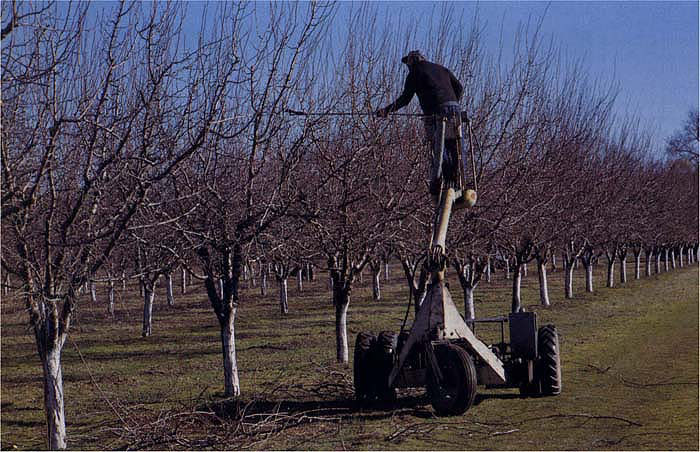All Issues
Alternate-year pruning may provide temporary savings
Publication Information
California Agriculture 48(6):13-17.
Published November 01, 1994
PDF | Citation | Permissions
Abstract
Effects of alternate-year pruning over four seasons on fruit production, quality and net revenues per tree compare favorably to those for traditional annual pruning methods. Alternate-year pruning may be feasible for growers interested in reducing pruning costs in a particular season. However, the cost to prune trees in the alternate year significantly affects revenues per tree.
Full text
Alternate-year pruning may be more suitable for prune orchards with widely spaced trees like this, than vigorous orchards planted to higher tree densities.
Pruning is done to develop tree structure, improve light penetration, remove dead and decayed wood and regulate cropping. The most critical benefit of mature tree pruning is crop regulation. Regular pruning is believed to improve fruit size and soluble solids while lowering fruit-drying ratios. Therefore, in most cases the economic benefits of pruning outweigh those of not pruning.
As farming costs continue to rise faster than revenues, growers are searching for ways to reduce expenses. For California prune growers, pruning is a significant production expense, often exceeding $125 per acre, and is usually targeted when growers need to reduce farming costs. To cut current season production costs, it might be possible to prune in alternate years.
The actual effects of alternate-year pruning on fruit size, drying ratios, yield or other aspects of fruit quality have not been previously demonstrated. Alternate-year pruning poses some potential problems. In the nonpruned year, trees could produce more fruit of small size. Low soluble solid content and high fruit-drying ratios are associated with smaller fruit. Furthermore, large crops lead to tree limb breakage and tree top potassium deficiencies. These concerns are especially important following light cropping seasons, when normal increases in flowering and cropping would be expected. In the nonpruned year, increased shading may reduce fruitful spur and shoot production for the next crop year. Conversely, in some instances alternate-year pruning may result in higher production in short crop years because not pruning increases the number of shoots bearing flowers and the potential for increased crop.
The purpose of this study was to determine whether alternate-year pruning could be used without significant declines in production, fruit size and fruit-drying ratios. Selected production costs were used to assess the economic impact of alternate-year pruning.
Three pruning treatments
Plant materials, experimental locations and measurements
To compensate for naturally occurring alternate bearing patterns and differences in growing locations, we examined three different pruning treatments — annual pruning, pruning in odd-numbered years and pruning in even-numbered years — from 1986 through 1989. Each treatment was compared in orchards in Tehama, Sutter and Merced counties over the 4 years. These locations represented environmental differences within the major prune-growing regions. Improved French prunes (Prunus domestica L.) growing on Myrobalan 29C rootstock (Prunus cerasifera) were used in Tehama and Sutter counties. Marianna 2624 (Prunus cerasifera × Prunus munsoniana?) was used as a rootstock in Merced. Single-tree plots in Tehama, Sutter and Merced counties were arranged in 32, 29 and 28 randomized blocks, respectively, perpruning treatment. Trees were fully mature (between 16 and 18 years old) and spaced at 6.1 meters (20 feet) between rows and 5.5 meters (18 feet) between trees (121 trees/acre). Soils and other farming practices varied with location, but were representative of local prune orchards. Trees were pruned by growers or by UC personnel in January. All trees were pruned in 1985, a light crop year (139,666 tons) statewide, the season before treatments began.
Alternate-year and annual pruning treatments were consistent in severity and type of wood removed across locations. Ten to 20 small (2.5 cm or less in diameter) branches were removed with thinning cuts. Heading cuts were rare and made only in tree tops. Trees were mechanically harvested annually.
Fresh yield per tree was measured each year with an electronic weighing load cell situated on the harvesting equipment. Dried fruit yield was calculated by commercially drying a random fruit sample of 1.35 to 1.8 kilograms (3 to 4 pounds) from each tree during harvest. The fresh sample weight was divided by the dry sample weight to obtain the fresh to dry weight ratio (drying ratio), which was used to calculate dry yield per tree. Number of dry fruit per pound (fruit size) and dried fruit size distribution were evaluated for each tree sample. Fruit that passed through a 23/32-inch (145 to 155 dried prunes per pound, 1988 and 1989) or 24/32-inch ring (120 to 130 prunes per pound, 1986 and 1987) were considered undersize, consistent with industry standards established during each experimental year.
Calculation of net revenue per tree
The economic impact of alternate-year pruning was assessed by making the following assumptions: Pruning costs were set at $1.50 per tree, and an average pruner pruned 5 trees per hour in each of the 4 years in the annually pruned trees. The cost of annual pruning was calculated to be $181.50 per acre. In the alternate pruning year, as much as 30% more time was needed to prune the trees. Generally, less than 30% extra time was required. A 30% increase in pruning time would reduce the number of trees pruned per hour from 5 to 3.5. Consequently, for conservative comparison, we increased the pruning costs to $259.29 per acre in the alternate year. Costs to harvest, haul and dry prunes were estimated at $93 per ton (fresh fruit weight) in each of the 4 years. No other production costs, including assessments, were subtracted from payments received for prunes. Prices received for prunes were calculated from the Prune Bargaining Association's 1986 through 1989 price schedules. The weights of fruit in the undersize category were subtracted from the dry fruit yield.
TABLE 1. Effect of alternate-year pruning at Tehama, Sutter and Merced counties locations over 4 years (1986–1989) on French prune dry fruit weight per tree
TABLE 2. Effect of alternate-year pruning at Tehama, Sutter and Merced counties locations over 4 years (1986–1989) on French prune fruit drying ratio
The calculations used for each year were as follows:
Net revenue per tree = [(dry yield per tree) − (undersize fruit) × ($ per fruit size)] − (pruning + harvesting and drying costs).
Potential savings associated with alternate-year pruning were equivalent to approximately $52 per acre per year.
Statistical analyses
Analyses of variance and Duncan's multiple range tests were conducted by using Statistical Analyses System's (SAS Institute, Cary, North Carolina) General Linear Models procedure. Highly significant treatment × location × year effects were found for all measured variables. Consequently, analyses of variance and treatment mean separation were performed for each year within each location.
4-year yields comparable
Dry fruit yield
In 1986, the first year of this pruning experiment, there were significant increases in dry yield per tree in nonpruned compared to pruned trees in the Tehama County and Merced County locations (table 1). At the more lightly cropped Sutter County location, yield was not affected by pruning treatment in that year. In subsequent years, nonpruned trees were not higher yielding than trees that were pruned annually, except at Merced in 1988. Additionally, alternate-year pruned trees were not lower yielding than annually pruned trees. Nonpruned alternate-year trees were lower yielding than pruned trees in Tehama in 1988. Overall, pruning in the alternate year did not lower yields. There were no yield differences among pruning treatments when averaged over 4 years.
TABLE 3. Effect of alternate-year pruning at Tehama, Sutter and Merced counties locations over 4 years (1986–1989) on French prune fruit size
TABLE 4. Effect of alternate-year pruning at Tehama, Sutter and Merced counties locations over 4 years (1986–1989) on the percentage of French prunes under a minimum size.
TABLE 5. Effect of alternate-year pruning at Tehama, Sutter and Merced counties locations over 4 years (1986–1989) on the net revenue per French prune tree.
Drying ratio and fruit size
Drying ratios were unaffected by treatment in 1986 (table 2), even though yield was higher in nonpruned Tehama and Merced County trees. Drying ratios were higher (poorer) in 1987, the pruned alternate year at Tehama County, even though dry yield was reduced. In subsequent years, no clear relationship was measurable between pruning treatment and drying ratio. Crop load, irrigation, potassium nutrition, site and climatic variation probably influence drying ratio more than the degree of pruning.
No clear trends were evident with regard to pruning treatment and percentage of undersize fruit at any location. Fruit size (dry fruit per kilogram) decreased with increased dry yield (tables 3 and 1) at the Tehama and Merced County locations in 1986. That relationship was generally consistent in all years. However, fruit size was not always related to pruning, and alternate-year pruned trees did not consistently bear different fruit size than annually pruned trees. Alternate-year pruning in 1987 and 1989 at the Tehama County location reduced average fruit size (table 3) and increased the percentage of undersize fruit when compared to annual pruning and alternate-year pruning in 1986 and 1988 (table 4). Percentage of undersize fruit was increased at the Merced County location by not pruning in 1986. Surprisingly, no pruning apparently led to less undersize fruit in 1988, and pruning in the alternate years 1987 and 1989 led to more undersize fruit when compared to trees annually pruned at Tehama County. Apparently, regular pruning as it was conducted in these experiments did not lead to consistent improvement in fruit size as expected.
There were no differences in tree growth as measured by trunk cross-sectional area after 4 years of alternate-year pruning treatment at any location (data not shown).
Net revenue per tree
In 1986, not pruning the alternate-year pruning plots increased net revenue per tree compared to the two pruned treatments at the Tehama County location (table 5). Similarly, revenue per tree was higher for the alternate-year treatment that was not pruned compared to the alternate-year pruned treatment at Sutter County. Alternate-year pruning treatments did not improve net returns per tree in subsequent years at Tehama County. Nonpruned trees had increased net revenue per tree at the Merced County location in 1987 and 1988. Net revenue per tree increased for nonpruned trees compared to pruned trees, while the lowest net revenue per tree resulted from pruning in the alternate year at Sutter County in 1988 and 1989. Alternate-year pruning treatment did not improve the 4-year average net returns per tree.
If and when to start
Annual pruning is currently a recommended practice in California prune growing. Pruning is known to reduce yield but improve fruit-drying ratios and size. These fruiting responses are principally regulated by the degree and selection of wood pruned. Our data showed that pruning trees in alternate years by standard methods did not consistently alter dry yield, drying ratios and dried prune size compared to annual pruning. Annual pruning, especially at the Tehama County location, did not regulate cropping to the degree expected. We believe this may be related to severity and selection of fruiting wood pruned. It may have been possible to increase pruning severity at the Tehama County location in 1987 and 1989 to reduce crop load, thereby improving fruit size and drying ratios. Growers pruned their trees uniformly from year to year, and the types and number of cuts made were based upon past experience in these experiments. No attempts were made to alter the pruning strategy as a function of previous cropping history.
An alternate-year pruning program may be viable for some growers. Our data showed that nonpruned trees produced higher dry yields than pruned trees in certain years, but fruit size generally decreased with increasing yield. In addition, field observations beginning in the 1987 season indicated that pruning after the unpruned year may take as much as 20 to 30% more time to accomplish. Consequently, net revenues per tree were not consistently improved by alternate-year pruning.
Alternate-year pruning programs are probably more acceptable for orchards planted at wide tree spacings and may not be suitable for vigorous orchards with higher tree densities. High density orchards require regular pruning to manage vegetative growth and ensure adequate light distribution in canopies. The trees used in these experiments were fully mature, were widely spaced and had not completely filled the allotted growing space. The need to manage tree vigor in these orchards was not as important as in a higher density prune orchard.
We believe it is important to consider when to start an alternate-year pruning program, even though after 4 years these data suggest a program could be started at any time. In any given year, especially in the first year (e.g., 1986) pruning can affect yield and fruit size, especially rigorous pruning. It is hard to predict how weather conditions through bloom will affect prune fruit set. However, there are tree growth and fruiting characteristics that could help to determine when to establish an alternate-year pruning program. It has often been shown that flower production and vegetative growth are reduced in the season following heavy crops. Because of reduced flower numbers and shoot growth, there is generally reduced cropping potential. Consequently, growers might consider doing little or no pruning in such a season, to leave as much fruiting wood as possible. Conversely, after a light crop, when fruiting potential and vegetative growth may have been encouraged, pruning should be increased with an eye toward regulating the expected heavy crop potential. Failure to prune on this schedule in an alternate-year pruning program could result in overcropping, reduced fruit sizes, spur fruitfulness and poor fruit quality. Growers should monitor the vigor in their orchards after heavy crops, then consider the start of an alternate-year pruning program.
An alternate-year pruning may take up to 30% longer than an annual pruning due to increased vegetative growth between prunings. Because of the additional time that may be needed to prune, alternate-year pruning did not consistently lead to better net revenues per tree.
No long-term effects
Over four consecutive fruit-growing seasons, we have observed that in any year pruning practices can modify the yield per tree, drying ratio, fruit size and revenue per tree. In addition to pruning, weather-related and other conditions occurring in individual orchards play a large role in regulating cropping. We found that annually pruned trees did not consistently outproduce trees that had been pruned in alternate years. More important, results showed that alternate-year pruning practices did not consistently affect fruit-drying ratio and size. In effect, we were unable to establish, from the results compiled to date, that alternate-year pruning had any long-term negative effects on fruit production or quality. However, because of the additional time needed to prune in the alternate year, alternate-year pruning did not consistently lead to improved net revenues per tree.
Because there are few negative effects associated with alternate-year pruning, we believe that it may be an advisable practice when financial resources are limited in any particular season. More than two seasons of no pruning is not recommended for high quality prune production. We suggest that an alternate-year pruning program be initiated as a nonpruning year following a heavy crop.
Currently, pruning costs for mature trees can range from $0.75 to $2.00 per tree every year. Prices vary from orchard to orchard because of differences in tree vigor, disease incidence, pruner's skill, and so on. With an alternate-year pruning program, pruning may take up to 30% longer than an annual pruning because of increased vegetative growth between prunings. An alternate-year pruning program may be attractive as a cost-saving measure, especially if the additional pruning time required is less than 30%.



